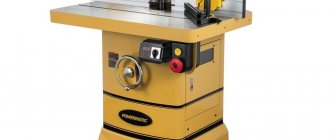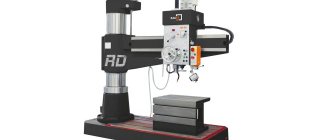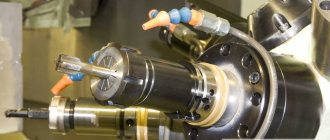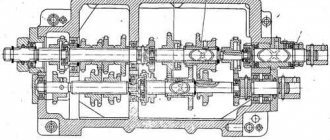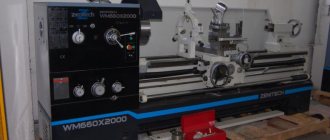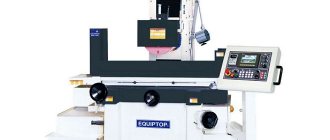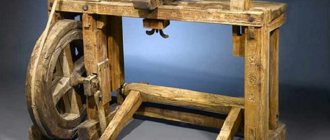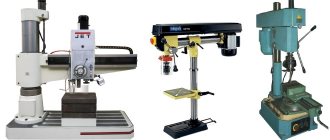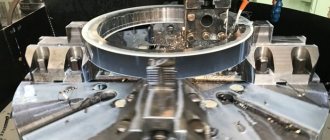A drilling and milling machine, which uses both a milling cutter and a drill as a working tool, is a universal device. Due to this, such machines are used in various fields of activity.
One of the types of drilling and milling machine
A drilling and milling machine, used primarily for processing metal workpieces, can be additionally equipped with numerical control, which improves the quality of technological operations and the accuracy of the geometric parameters of the finished product. On drilling and milling machines, you can efficiently and accurately process parts with curved surfaces, regular and irregular shapes, carry out precise calibration, form holes, cut threads in them, make grooves with a smooth inner surface and ridges of even very small sizes. In addition, drilling and milling machines are successfully used for processing elements of spline and tongue joints.
Modern manufacturers producing such machines offer a wide variety of modifications. Models of drilling and milling machines equipped with CNC systems are considered high-tech. Such models, in addition to high accuracy and maximum productivity, are also convenient because the influence of the human factor on them is minimized during processing.
Very popular are machines that can be installed and fixed on a flat metal surface using a magnetic base. The sole allows you to fix the machine not only on the surface of a metal work table, but also directly on the workpiece being processed, if its surface area allows this.
Design and functionality
Any milling and drilling machine, regardless of its modification, has a distinctive feature - a special spindle mounted on a movable support. The design of such a machine also includes a reliable frame and work table, which makes it easy to secure the workpiece and process it.
The work table of a drilling and milling machine is a massive three-dimensional structure, which is made from metal by casting or pressing. As mentioned above, certain models of machines in this group can be equipped with a magnetic sole, which allows them to be securely fixed in various planes. Such machines are made in the form of compact portable devices; they are quickly installed directly on those metal surfaces that need to be processed.
Machine made by Taiwanese manufacturer Denver
Drilling and milling machines can perform almost all types of drilling and milling work; they can process workpieces of various types. Such high functionality is ensured by the high rotation speed of the spindle with the tool.
Equipping machines of this category with CNC systems can significantly simplify the process of equipment management, as well as improve the quality of finished products. A CNC drilling and milling machine can perform processing in three planes, which makes it possible to use it to produce products of complex configurations that exactly correspond to a drawing or prototype. Simple retrofitting of such a machine with movable carriages, clamps and grooves allows it to be used for processing tenons and grooves of complex configurations. Very often, machines of this category are used to grind the edges of parts of various configurations.
Milling and drilling equipment combines two types of machines in its design - drilling and milling. At the same time, the functionality and operating potential of such devices is much higher than that of a single highly specialized machine. Thanks to this, milling and drilling machines are used today not only in industrial enterprises - they are also equipped in many home workshops and garages. Moreover, in the arsenal of many home craftsmen you can find a desktop drilling and milling machine equipped with a CNC system. Such equipment, having enormous capabilities, has compact dimensions and can be easily installed even in a small workshop or garage.
Purpose of drilling and milling machines
On a milling and drilling machine, a part is processed from one installation, drilling and milling operations are carried out along a plane. The equipment is intended for the production of spare parts that are in demand when repairing machines and various mechanisms, and for the independent creation of original devices. In private workshops it is possible to produce small batches of parts. At enterprises with mass production of products, combined models such as drilling and milling equipment are not used, or floor-mounted CNC units are installed.
The following operations are performed on milling and boring machines:
- drilling;
- milling;
- boring;
- countersinking;
- thread cutting;
- selection of grooves;
- spline milling;
- cutting combs.
The use of conical and disk-shaped flap wheels allows grinding along the plane and inside holes on drilling and milling equipment. Circles designed for grinders and routers are installed.
To perform operations, the tool changes, depending on the type of processing. FS 1, a tabletop drilling and milling machine, is popular in repair shops and private entrepreneurs. It is designed for processing workpieces up to 200 mm high and 450 mm long. It is used for drilling, tapping and milling along planes, including ends. FS 1 has manual control. Rotation from the motor to the spindle is transmitted by belts.
The following types of parts are manufactured using drilling and milling equipment:
- slabs;
- crackers;
- dowels;
- levers;
- shoes;
- housings.
The precision of milling and the cleanliness of processing allow us to make templates of various configurations for processing metal and wooden parts using copiers. The following grooves are made using shaped cutters:
- rectangular;
- T-shaped;
- dovetail.
When connected to a CNC machine, splines are cut on the shafts, gear racks and fastening bolts with figured heads are made for the grooves on the plates.
Drilling and milling machines can process gypsum, stone, and wood in addition to metal. They are used in construction when laying communication routes. The equipment is suitable for cutting ventilation holes, tapping threads in fittings, and making recesses in bricks.
General characteristics
Drilling and milling equipment (both manually controlled and equipped with a CNC system) is not only highly functional, it is reliable and safe to operate. The versatility and capabilities of such a machine are ensured both by its design features and by the fact that it can perform processing using various tools. Thus, cutters, drills, taps, reamers, countersinks and other tools can be installed in the spindle of a drilling and milling machine.
Processing of workpieces made of metal or other material on such a device is carried out due to the rotation and translational movement of a working tool fixed in the spindle. An electric motor is responsible for rotation, transmitting it through a system of drive mechanisms. In drilling and milling machines that are equipped with a CNC system, all operating modes are set by special commands transmitted to the controls.
Cantilever drilling and milling machine from DEKA
When carrying out drilling and milling work, the workpiece and all equipment components absorb significant loads, so the machine must have very high rigidity. If you neglect this requirement, then you may not only fail to obtain the required quality and accuracy of the finished product, but also encounter the fact that the workpiece will move from side to side during processing. Modern manufacturers producing drilling and milling machines carefully develop their design to ensure high rigidity.
The convenience and high efficiency of working with such equipment is also ensured by the fact that the tool in its spindle head is replaced very quickly, without any complex manipulations. At the same time, the reliability of tool fastening is at a high level.
What kind of metal work can be done
Drilling and milling machines for metal are capable of performing almost any drilling and milling operations. The high functionality of the unit is due to the high speed of the spindle with the tool. If a metal drilling and milling machine is equipped with CNC, the processing will be more accurate and the quality of the resulting product will be higher.
Drilling
On a metal drilling and milling machine, you can perform both blind and through drilling. The hole is obtained with an exact size only if the preparatory and main work is strictly carried out. When carrying out through drilling, it is necessary to switch the automatic transmission to manual at the moment the drill comes out of it. This will ease the pressure on the drill. During the process, it is necessary to periodically remove the drill from the hole and remove chips from there.
Milling
Depending on the operations performed on a metal drilling and milling machine, the equipment changes. For milling, various grinding wheels of conical and disk shapes are used. They allow grinding both along the plane and inside the holes. The accuracy of milling depends on the specific model. The configuration of metal parts that are made using copiers depends on the accuracy.
Boring
Boring is the process of increasing the diameter of a hole, as well as cleaning it. For through boring, through cutters are used; when boring blind holes, through stop cutters are used. Boring is less productive than drilling, but at the same time allows you to process parts with a large diameter.
Thread cutting
A tap is used to cut threads. It is used for internal metric threads. Taps can be of two types: for roughing and finishing work. We select the diameter of the drill depending on the diameter of the thread and its pitch. It is impossible to make a blind thread without the reverse function. A through one can also be done on a machine where there is no reverse, but in this case, the tap must be pulled out manually.
Grooving
A groove is a recess of metal in a part that is limited by shaped or flat surfaces. The groove can be:
- T-shaped;
- dovetail;
- shaped;
- end-to-end;
- open or closed.
Shaped, disk and end mills are used to cut grooves. When milling precise slots, the size of the disk cutter should be less than the width of the slot. To mill special profiles, for example, dovetails, it is necessary to use vertical or longitudinal milling machines in 3 or 2 transitions.
Spline milling
There are 3 types of spline connections:
- straight-sided;
- triangular;
- involute.
Splines are used to transmit rotational motion between shafts and bushings. Spline cutting occurs in several stages, which include roughing and finishing, slot milling, deburring, grinding and heat treatment.
Comb cutting
This is another operation that, along with cutting splines, is performed on a metal drilling and milling machine. The part is processed on three sides. To process long parts, a spindle and support mounted on a table are used.
Capabilities of CNC models
More and more models of modern metal drilling and milling machines are being used using CNC. This expands production capabilities. Program control has several obvious advantages:
- it is enough to use one operator who can operate several machines in parallel;
- the accuracy and quality of part processing increases;
- productivity increases by an order of magnitude;
- Such machines have advanced functionality.
In fact, the drilling and milling machine works independently according to the program established by the operator.
What criteria should you rely on when choosing?
First of all, it is important to consider for what work the equipment is purchased. For use in a small workshop, you should not buy an overly powerful drilling and milling machine. It is necessary to evaluate the dimensions of the equipment, as well as the table on which it will be located.
It is necessary to choose a specific model based on its functionality, since they may differ. It is not necessary to pay attention to expensive equipment, since it may not justify itself.
